Artificial Intelligence (AI) Market by Offering (Hardware, Software), Technology (ML (Deep Learning (LLM, Transformers (GPT 1, 2, 3, 4)), NLP, Computer Vision), Business Function, Vertical, and Region - Global Forecast to 2030
[300 Pagees Report] The artificial intelligence market size to grow from USD 150.2 billion in 2023 to USD 1,345.2 billion by 2030, at a Compound Annual Growth Rate (CAGR) of 36.8% during the forecast period. Artificial intelligence (AI) is revolutionizing multiple industries, positioning itself as a key driver for emerging technologies such as big data analytics, robotics, and the Internet of Things (IoT). Furthermore, the rise of generative AI tools such as ChatGPT and AI art generators highlights its mainstream prominence. With its continued trajectory, AI is set to persist as a powerful technological innovator, propelling advancements in the foreseeable future.
Technology Roadmap of Artificial Intelligence till 2030
The artificial intelliegnce market report covers technology roadmap till 2030, with insights around short-term, mid-term, and long-term developments.
Short-term roadmap (2023-2025)
- Advancements in generative models for content creation.
- Growing Adoption of Federated Learning for Privacy-Preserving Distributed Model Training.
- Advancing transparency and interpretability through Explainable AI methods in decision-making.
- Edge AI gains traction with decentralized Al processing and decision-making.
Mid-term roadmap (2025-2028)
- Sophisticated Generative AI models boost quality and diversity.
- Advancements in federated optimization algorithms and secure aggregation methods boost scalability and performance of federated learning systems.
- Explainable AI will enhance the interpretability and transparency of AI models.
- Edge AI will become more sophisticated, leveraging advanced hardware and algorithms.
Long-term roadmap (2028-2030)
- Al-generated content reaches human-level sophistication, redefining artificial and human creativity.
- Wide deployment of federated learning empowers secure and scalable solutions across industries.
- Explainable AI emerges as a fundamental requirement for AI systems in all industries.
- Advanced AI processing on edge devices for autonomous decision-making, real-time intelligence, and efficient data processing in diverse environments.
Business Models of Artificial Intelligence Market
The artificial intelliegnce market report covers business models in artificial intelligence market, with insights around various AI-based business model innovations.
AI SaaS Product Vendor
- Develop and maintain AI applications and services that address specific use cases or industries.
- Offers scalable and accessible platform where customers leverage AI capabilities without the need for extensive technical expertise.
AI Platform Vendor
- Offer a suite of tools, frameworks, and services that support the entire AI development lifecycle.
- Enable developers and organizations to leverage the platform's capabilities to build and deploy AI models at scale.
AI Licensing and Intellectual Property Vendor
- Involves the development, licensing, and monetization of AI technologies and intellectual property assets.
- Leverages intellectual property assets to generate revenue and drive innovation in the AI industry.
AI Technical Consulting Vendor
- Offer a range of services, including AI strategy development, implementation planning, algorithm design, and model deployment.
- Bridges the gap between AI expertise and client requirements, enabling successful AI adoption.
AI Management Consulting Vendor
- Offer expertise in organizational readiness assessment, business process optimization, and AI implementation roadmaps.
- Aims to drive organizational transformation and maximize the value of AI investments.
AI Research and Development Vendor
- Invest in R&D efforts to explore novel algorithms, models, and applications.
- Aims to drive innovation and shape the future of AI technologies.
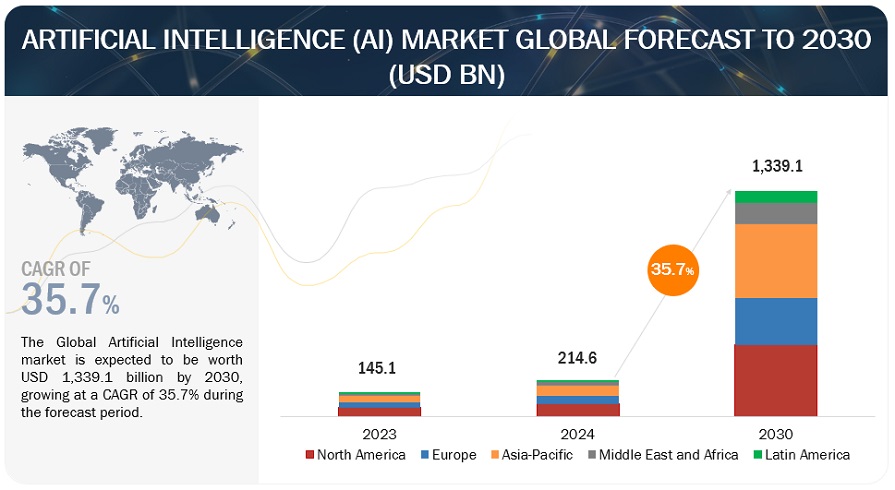
To know about the assumptions considered for the study, Request for Free Sample Report
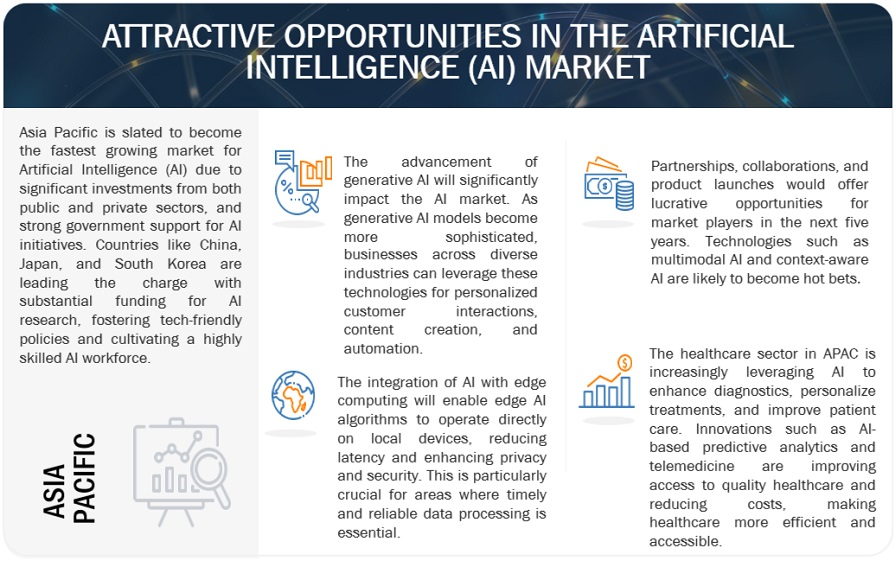
To know about the assumptions considered for the study, download the pdf brochure
Market Dynamics
Driver: Growth in the adoption of autonomous artificial intelligence
The increasing adoption of autonomous artificial intelligence (AI) is driving the growth of the AI market. This trend is fueled by advancements in algorithms, machine learning techniques, and natural language processing, enabling the development of sophisticated autonomous AI systems. These systems offer improved accuracy and reliability, attracting organizations from various industries. Autonomous AI optimizes operations, leading to cost savings and enhanced productivity. It finds applications in healthcare, finance, manufacturing, transportation, and retail sectors. The cost reduction associated with autonomous AI, driven by automation, further drives its adoption. As technology advances and more industries recognize its benefits, the AI market is poised for expansion, fostering innovation and new opportunities.
Restraint: Issues related with data availability and quality
Data availability and quality play a crucial role in restraining the growth of the AI market. Limited data availability, particularly in niche industries or specialized domains, hinders the development and application of AI solutions. Without access to comprehensive and diverse datasets, AI algorithms lack the necessary training to make accurate predictions and decisions. Moreover, the quality of data is vital for the effectiveness of AI systems. Inaccurate, incomplete, or biased data leads to flawed outcomes and unreliable AI models. Ensuring data quality requires meticulous data cleaning, preprocessing, and validation processes, which are time-consuming and resource-intensive. Organizations with limited resources struggle to meet these requirements, hindering the development and deployment of AI solutions. To address these issues, it is important to promote data sharing collaborations, invest in data collection and preprocessing capabilities, and establish industry-wide standards for data quality and privacy. These efforts will enhance data availability, improve data quality, and create a more conducive environment for the growth of the AI market.
Opportunity: Rapid growth in the digital data form various sources
The exponential growth of digital data from various sources presents immense opportunities for the AI market. With the proliferation of connected devices, social media platforms, online transactions, and sensors, an unprecedented volume of data is generated every day. This abundance of data offers a vast and diverse resource for AI algorithms to leverage. AI thrives on data, and the availability of large and diverse datasets enables AI systems to learn, analyze, and make accurate predictions. The more data available, the better AI algorithms understand patterns, trends, and correlations. This empowers businesses and organizations to gain valuable insights, make data-driven decisions, and drive innovation. For instance, in marketing, AI algorithms analyze extensive customer data to identify preferences, personalize campaigns, and improve engagement. In healthcare, AI analyzes patient data to identify early signs of diseases, provide personalized treatment plans, and enhance patient care. Furthermore, the growth of digital data fuels the development of AI technologies and solutions. The increasing availability of data spurs investment in AI research and development, leading to advancements in algorithms, machine learning models, and data processing techniques.
Challenge: Concerns related to inaccurately and bias generated output
Issues related to bias and inaccurately generated output pose significant challenges to the growth of the AI market. When AI algorithms are biased or trained on biased data, they perpetuate discriminatory practices or reinforce societal prejudices. For instance, biased facial recognition systems have exhibited higher error rates for women and people with darker skin tones, leading to potential misidentification and discrimination. Such biases erode trust and hinder the adoption of AI technologies, particularly in sensitive areas such as hiring, law enforcement, and healthcare. Moreover, inaccurately generated output from AI systems has serious consequences. For instance, in the healthcare sector, if an AI system inaccurately diagnoses a medical condition or recommends incorrect treatments, it poses risks to patients' health and safety. Such incidents undermine confidence in AI and slow down its adoption. Addressing these challenges requires ongoing efforts to detect and mitigate bias in AI algorithms, improve data quality, and enhance the accuracy and transparency of AI systems to build trust and ensure responsible AI deployment.
Artificial Intelligence Market Ecosystem
The artificial intelligence market report covers market ecosystem which comprises software provider, service provider, cloud provider, hardware and devices provider, network provider, and security provider.
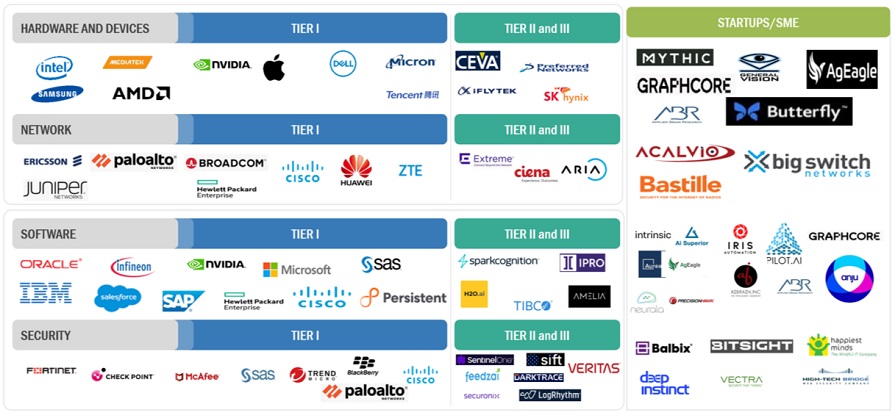
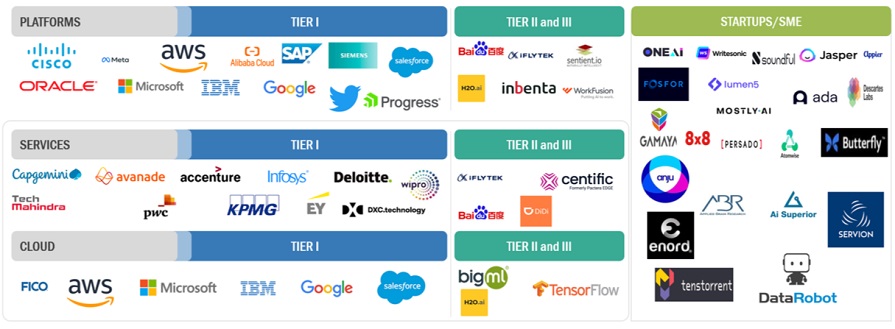
The computer vision segment is expected to grow at the highest CAGR during the forecast period
Based on technology, the artificial intelligence market is segmented into Machine Learning, Natural Language Processing, Context-Aware, and Computer Vision. Computer vision enables innovation in various domains, including self-driving cars, facial recognition, and augmented reality. It enhances consumer experiences, reduces costs, and strengthens security. Manufacturers detect defects, insurance assessors evaluate vehicle damage, medical professionals analyze medical images, and banks verify customer identities using computer vision applications. Its wide-ranging impact across industries demonstrates its significance in driving technological advancements. As a result, the computer vision technology is anticipated to grow at the highest CAGR during the forecast period.
North America to account for the largest market size during the forecast period
North America has emerged as a leading hub for artificial intelligence (AI) adoption, with significant developments and applications across various sectors. The region's favorable ecosystem, coupled with collaborations between academia, industry, and government, has created a fertile ground for AI research, development, and commercialization. As a result, North America continues to be at the forefront of AI adoption, driving technological advancements and shaping the future of AI applications.
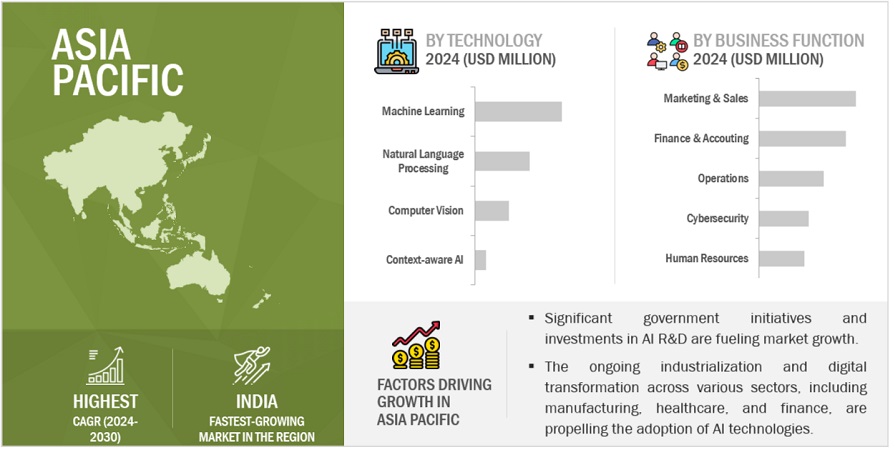
Key Market Players
The artificial intelligence providers have implemented various types of organic and inorganic growth strategies, such as new product launches, product upgradations, partnerships and agreements, business expansions, and mergers and acquisitions to strengthen their offerings in the market. The major players in the artificial intelligence market include Google (US), Microsoft (US), IBM (US), Oracle (US), AWS (US), Intel (US), Salesforce (US), SAP (Germany), Cisco (US), Meta (US), HPE (US), Siemens (Germany), Huawei (China), NVIDIA (US), Baidu (China), SAS Institute (US), OpenAI (US), H2O.ai (US), iFLYTEK (China), Alibaba Cloud (China), General Vision (US), Darktrace (UK), Blackberry Limited (Canada), DiDi Global (China), Face++ (China), Inbenta (US), Anju Software (US), Butterfly Network (US), Atomwise (US), AIBrain (US), SK Hynix (South Korea), Progress (US), PrecisionHawk (US), AgEagle Aerial System (US), Neurala (US), Twitter (US), Aurea Software (US), Persado (US), 8x8 (US), Appier (Taiwan), GumGum (US), IPRO (US), Graphcore (UK), Preferred Networks (Japan), Applied Brain Research (Canada), Pilot AI (US), Iris Automation (US), Gamaya (Switzerland), ec2ce (Spain), Descartes Labs (US), Mythic (US), Ada (Canada), Mostly AI (Austria), Sentient.io (Singapore), Lumen5 (Canada), AI Superior (Germany), Fosfor (India), Intrinsic (US), Jasper (US), Soundful (US), Writesonic (US), One AI (Israel).
Get online access to the report on the World's First Market Intelligence Cloud
- Easy to Download Historical Data & Forecast Numbers
- Company Analysis Dashboard for high growth potential opportunities
- Research Analyst Access for customization & queries
- Competitor Analysis with Interactive dashboard
- Latest News, Updates & Trend analysis
Request Sample Scope of the Report
Get online access to the report on the World's First Market Intelligence Cloud
- Easy to Download Historical Data & Forecast Numbers
- Company Analysis Dashboard for high growth potential opportunities
- Research Analyst Access for customization & queries
- Competitor Analysis with Interactive dashboard
- Latest News, Updates & Trend analysis
|
Report Metrics |
Details |
|
Market size available for years |
2017–2030 |
|
Base year considered |
2022 |
|
Forecast period |
2023–2030 |
|
Forecast units |
USD (Billion) |
|
Segments covered |
Offering, Technology, Business Function, Verticals, and Region |
|
Geographies covered |
North America, Europe, Asia Pacific, Middle East & Africa, and Latin America |
|
Companies covered |
Google (US), Microsoft (US), IBM (US), Oracle (US), AWS (US), Intel (US), Salesforce (US), SAP (Germany), Cisco (US), Meta (US), HPE (US), Siemens (Germany), Huawei (China), NVIDIA (US), Baidu (China), SAS Institute (US), OpenAI (US), H2O.ai (US), iFLYTEK (China), Alibaba Cloud (China), General Vision (US), Darktrace (UK), Blackberry Limited (Canada), DiDi Global (China), Face++ (China), Inbenta (US), Anju Software (US), Butterfly Network (US), Atomwise (US), AIBrain (US), SK Hynix (South Korea), Progress (US), PrecisionHawk (US), AgEagle Aerial System (US), Neurala (US), Twitter (US), Aurea Software (US), Persado (US), 8x8 (US), Appier (Taiwan), GumGum (US), IPRO (US), Graphcore (UK), Preferred Networks (Japan), Applied Brain Research (Canada), Pilot AI (US), Iris Automation (US), Gamaya (Switzerland), ec2ce (Spain), Descartes Labs (US), Mythic (US), Ada (Canada), Mostly AI (Austria), Sentient.io (Singapore), Lumen5 (Canada), AI Superior (Germany), Fosfor (India), Intrinsic (US), Jasper (US), Soundful (US), Writesonic (US), One AI (Israel). |
This research report categorizes the artificial intelligence market based on component, type, infrastructure type, deployment type, organization size, vertical, and region.
By Offering:
-
Hardware
- Accelerators
-
Processors
- Microprocessing Unit
- Graphics Processing Unit
- Field Programmable Gate Arrays
- Other Processors
- Memory
- Network
-
Software
-
By Type
- Pre-trained Models
- Customizable AI
- Edge AI
- AI Marketplaces
-
By Deployment
- Cloud
- On-Premises
-
By Type
-
Services
-
Professional Services
-
Consulting Services
- Training & Education
- Designing & Testing
- Deployment and Integration
- Support and Maintenance
-
Consulting Services
- Managed Services
-
Professional Services
By Technology:
-
Machine Learning
-
Deep Learning
- Convolutional Neural Networks (CNN)
- Recurrent Neural Networks (RNN)
- Generative Adversarial Networks (GAN)
-
Transformers
- GPT 1
- GPT 2
- GPT 3
- GPT 4
- Large Language Models (LLMs)
- Supervised Learning
- Unsupervised Learning
- Reinforcement Learning
-
Deep Learning
-
NLP
- Natural Language Understanding (NLU)
- Natural Language Generation (NLG)
- Context awareness
- Computer Vision
By Business Function:
- Finance
- Security
- Human Resources
- Law
- Marketing and sales
- Operations
- Supply Chain Management
By Verticals:
- BFSI
- Retail & Ecommerce
- Automotive, Transportation and Logistics
- Government & Defense
- Healthcare & Life Sciences
- Telecom
- Energy & Utilities
- Manufacturing
- Agriculture
- IT/ITeS
- Media & Entertainment
- Other Verticals (Construction, Education, and Travel & Hospitality)
By Region:
-
North America
- US
- Canada
-
Europe
- UK
- Germany
- France
- Italy
- Spain
- Nordic
- Balkans
- Rest of Europe
-
Asia Pacific
- China
- India
- South Korea
- ANZ
- Japan
- ASEAN
- Rest of Asia Pacific
-
Middle East and Africa
- KSA
- Israel
- Egypt
- UAE
- South Africa
- Rest of Middle East & Africa
-
Latin America
- Brazil
- Mexico
- Argentina
- Central America
- Rest of Latin America
Recent Developments:
- In May 2023, Google announced the launch of two new AI powered solutions named Target and Lead Identification Suite, and Multiomics Suite for the life sciences industry, aimed at expediting drug discovery and precision medicine for biotech companies, pharmaceutical firms, and public sector organizations.
- In May 2023, HPE announced an enhancement to its HPE Ezmeral Software platform. HPE Ezmeral Software expands the data and analytics capabilities of HPE GreenLake, extending from the edge to the cloud. It serves as the foundation for machine learning (ML) and artificial intelligence (AI) initiatives, providing the necessary infrastructure and tools for data processing and analysis.
- In April 2023, IBM unveiled its new security suite named IBM Security QRadar Suite, which is designed to unify and boost the security analyst experience throughout the whole incident lifecycle. The IBM Security QRadar Suite represents a significant evolution and expansion of the QRadar brand, encompassing all fundamental threat detection, investigation, and response capabilities. It has a single, updated user interface for all products that is integrated with cutting-edge AI and automation to enable analysts to work more quickly, effectively, and precisely across their main toolsets.
- In March 2023, Cisco has announced a number of new AI-powered innovations for its Webex collaboration platform. These innovations are designed to help organizations create more engaging and productive hybrid work experiences.
- In September 2022, SAP introduced recent improvements to the SAP SuccessFactors HXM Suite that bring together data, machine learning and artificial intelligence (AI) to provide organizations with a better understanding of the capabilities within their workforce.
Frequently Asked Questions (FAQ):
What is Artificial Intelligence (AI)?
How big is the AI market?
What is growth rate of the AI market?
What are the top AI Companies?
Who will be the leading hub for AI Market?
Will AI market be in high demand?
To speak to our analyst for a discussion on the above findings, click Speak to Analyst
The research study for the artificial intelligence market involved the use of extensive secondary sources and directories, as well as various reputed open-source databases, to identify and collect information useful for this technical and market-oriented study. In-depth interviews were conducted with various primary respondents, including key opinion leaders, subject matter experts, high-level executives of multiple companies providing artificial intelligence offering, and industry consultants to obtain and verify critical qualitative and quantitative information and assess the market prospects and industry trends.
Secondary Research
In the secondary research process, various sources were referred to, for identifying and collecting information for this study. Secondary sources included annual reports, press releases, and investor presentations of companies; white papers, journals, and certified publications; and articles from recognized authors, directories, and databases. The data was also collected from other secondary sources, such as Data Science Journal, Institute of Electrical and Electronics Engineers (IEEE) Journals and magazines, and Journal/forums for ML, AI India magazine, Customer Experience magazine, and other magazines. The artificial intelligence spending of various countries was extracted from respective sources. Secondary research was mainly used to obtain key information about the industry’s value chain and supply chain to identify key players based on solutions, services, and market classification and segmentation according to offerings of major players, industry trends related to solutions, services, deployment modes, applications, verticals, and region, and key developments from both market and technology-oriented perspectives.
Primary Research
In the primary research process, various primary sources from the supply and demand sides were interviewed to obtain qualitative and quantitative information on the market. The primary sources from the supply side included various industry experts, including Chief Experience Officers (CXOs), Vice Presidents (VPs), directors from business development, marketing, and product development/innovation teams, related key executives from AI solution vendors, SIs, professional service providers, and industry associations, and key opinion leaders.
Primary interviews were conducted to gather insights, such as market statistics, revenue data collected from solutions and services, market breakups, market size estimations, market forecasts, and data triangulation. Primary research also helped understand various technology trends, applications, deployments, and regions. Stakeholders from the demand side, such as Chief Information Officers (CIOs), Chief Technology Officers (CTOs), Chief Strategy Officers (CSOs), and end-users using artificial intelligence solutions, were interviewed to understand the buyer’s perspective on suppliers, products, service providers, and their current usage of artificial intelligence solutions and services, which would impact the overall artificial intelligence market.
The following is the breakup of primary profiles:
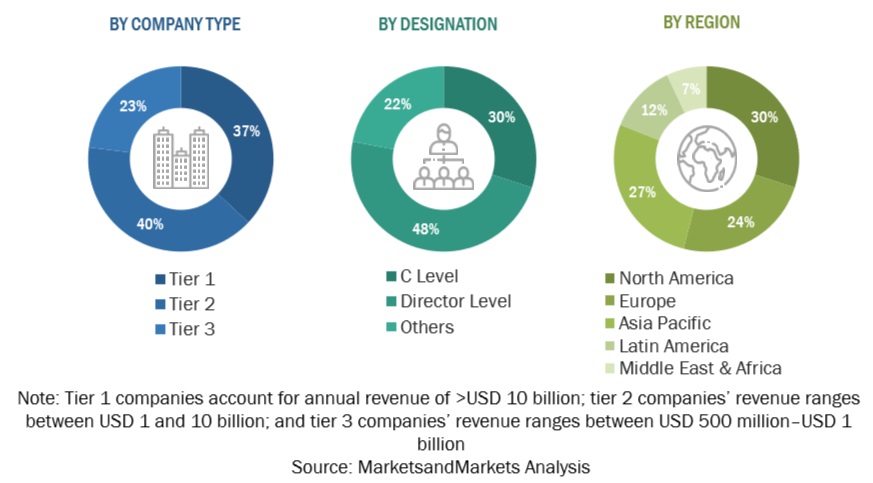
To know about the assumptions considered for the study, download the pdf brochure
Market Size Estimation

To know about the assumptions considered for the study, Request for Free Sample Report
Top-down and bottom-up approaches were adopted for estimating and forecasting the artificial intelligence market. In the top-down approach, an exhaustive list of all the vendors offering hardware, software, and services in the artificial intelligence market was prepared. The revenue contribution of the market vendors was estimated through annual reports, press releases, funding, investor presentations, paid databases, and primary interviews. Each vendor's offerings were evaluated on the basis of breadth of solutions and services, deployment modes, applications, and verticals. The aggregate of all the companies’ revenue was extrapolated to reach the overall market size. Each subsegment was studied and analyzed for its global market size and regional penetration. The markets were triangulated through both primary and secondary research. The primary procedure included extensive interviews for key insights from industry leaders, such as CIOs, CEOs, VPs, directors, and marketing executives. The market numbers were further triangulated with the existing MarketsandMarkets’ repository for validation.
In the bottom-up approach, the adoption rate of artificial intelligence solutions among different end-users in key countries with respect to their regions that contribute the most to the market share was identified. For cross-validation, the adoption of artificial intelligence solutions and services among industries, along with different use cases with respect to their regions, was identified and extrapolated. Weightage was given to use cases identified in different regions for the market size calculation.
All the possible parameters that affect the market covered in the research study have been accounted for, viewed in extensive detail, verified through primary research, and analyzed to get the final quantitative and qualitative data. The data is consolidated and added with detailed inputs and analysis from MarketsandMarkets.
- The pricing trend is assumed to vary over time.
- All the forecasts are made with the standard assumption that the accepted currency is USD.
- For the conversion of various currencies to USD, average historical exchange rates are used according to the year specified. For all the historical and current exchange rates required for calculations and currency conversions, the US Internal Revenue Service’s website is used.
- All the forecasts are made under the standard assumption that the globally accepted currency, USD, remains constant during the next five years.
- Vendor-side analysis: The market size estimates of associated solutions and services are factored in from the vendor side by assuming an average of licensing and subscription-based models of leading and innovative vendors.
- Demand/end-user analysis: End users operating in verticals across regions are analyzed in terms of market spending on AI solutions based on some of the key use cases. These factors for the AI tool industry per region are separately analyzed, and the average spending was extrapolated with an approximation based on assumed weightage. This factor is derived by averaging various market influencers, including recent developments, regulations, mergers and acquisitions, enterprise/SME adoption, startup ecosystem, IT spending, technology propensity and maturity, use cases, and the estimated number of organizations per region.
Data Triangulation
After arriving at the overall market size using the market size estimation processes as explained above, the market was split into several segments and subsegments. To complete the overall market engineering process and arrive at the exact statistics of each market segment and subsegment, data triangulation, and market breakup procedures were employed, wherever applicable. The overall market size was then used in the top-down procedure to estimate the size of other individual markets via percentage splits of the market segmentation.
Market Definition
According to IBM, Artificial Intelligence (AI) refers to the ability of a computer or machine to mimic the capabilities of the human mind, such as learning from examples and experience, recognizing objects, understanding, and responding to language, making decisions, solving problems, and performing tasks that humans typically do, such as greeting a hotel guest or driving a car.
Key Stakeholders
- AI solution providers
- Independent Software Vendors (ISVs)
- Investors and Venture Capitalists (VCs)
- Managed service providers
- Support and maintenance service providers
- System Integrators (SIs)/migration service providers
- Value-Added Resellers (VARs) and distributors
Report Objectives
- To define, describe, and predict the Artificial Intelligence market by offering (hardware, software, and services), technology, business function, vertical, and region.
- To provide detailed information related to major factors (drivers, restraints, opportunities, and industry-specific challenges) influencing the market growth.
- To analyze opportunities in the market and provide details of the competitive landscape for stakeholders and market leaders.
- To forecast the market size of segments with respect to five main regions: North America, Europe, Asia Pacific (APAC), Middle East & Africa (MEA), and Latin America
- To profile key players and comprehensively analyze their market rankings and core competencies.
- To analyze competitive developments, such as partnerships, new product launches, and mergers and acquisitions, in the Artificial Intelligence (AI) market
- To analyze the impact of the recession in the Artificial Intelligence (AI) market
Available Customizations
With the given market data, MarketsandMarkets offers customizations as per the company’s specific needs. The following customization options are available for the report:
Product Analysis
- Product matrix provides a detailed comparison of the product portfolio of each company
Geographic Analysis
- Further breakup of the North American AI market
- Further breakup of the European AI market
- Further breakup of the Asia Pacific AI market
- Further breakup of the Latin American AI market
- Further breakup of the Middle Eastern and African AI market
Company Information
- Detailed analysis and profiling of additional market players up to 5




 Generating Response ...
Generating Response ...







Growth opportunities and latent adjacency in Artificial Intelligence (AI) Market